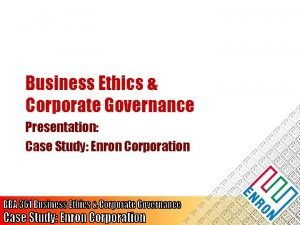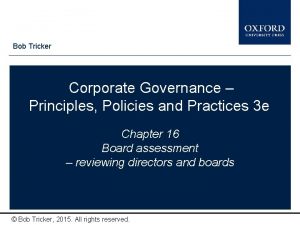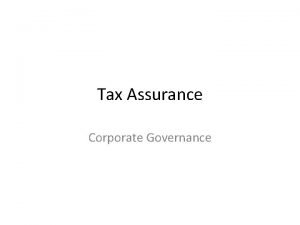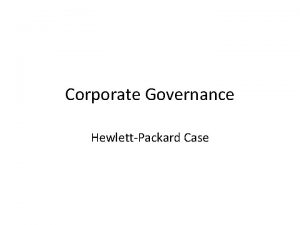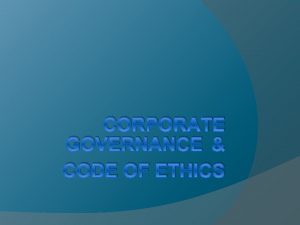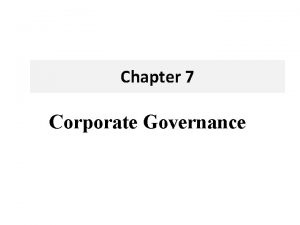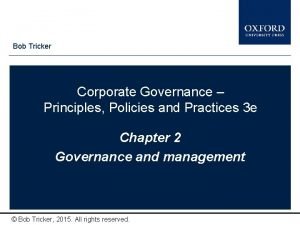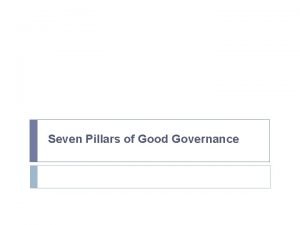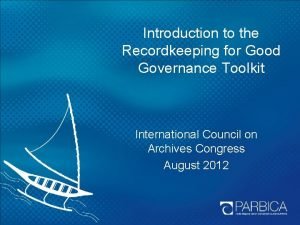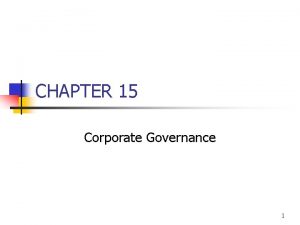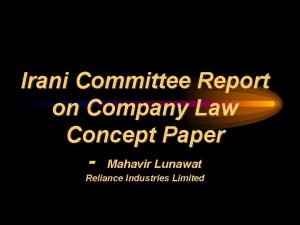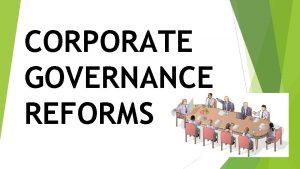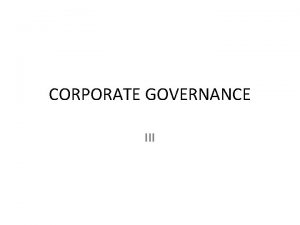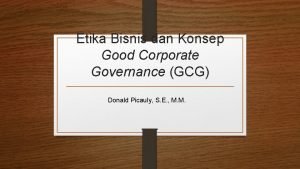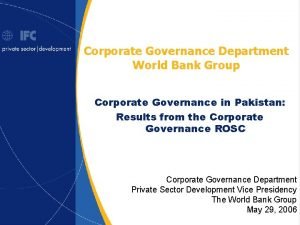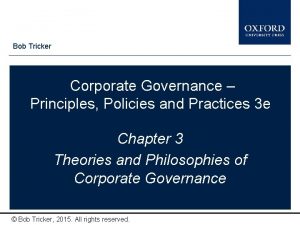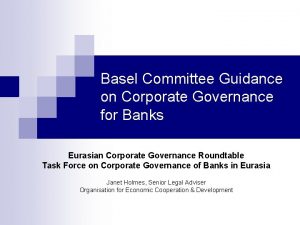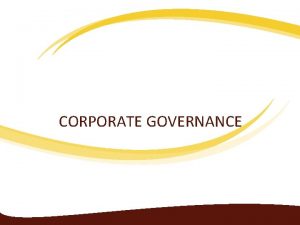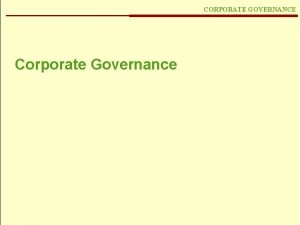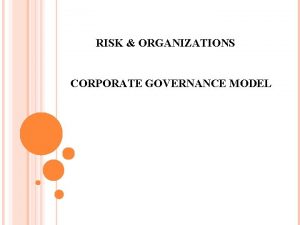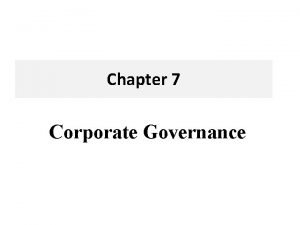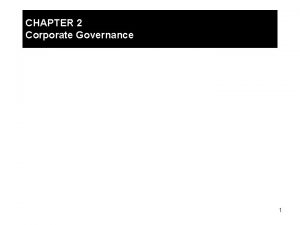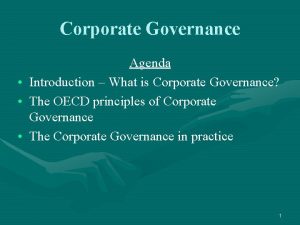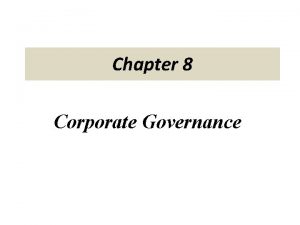Strategic management 5 Corporate governance and concepts of































































- Slides: 63

Strategic management 5. Corporate governance and concepts of responsible management

Influences on organisational purposes Corporate Governance Who should the organisation serve? How should purposes be determined? Business Ethics Which purposes should be prioritised? Why? Organisational purposes Mission Objectives Stakeholders Whom does the organisation serve? Cultural context Which purposes are prioritised? Why?

What is a corporation? n n n Collective ownership of an enterprise limited liability as essential element risk taking The owners delegate the responsibility of taking decisions, or actions flexibility in determining capital and governance structure role of the state is only registration

Early concepts of the corporation municipalities, universities n first joint stock companies, 17 th century, Britain, Holland n private sector The corporate form became the governments’ ally. The level of independence of corporate form made more acceptable the authority of governments’. n

Evolution of the Modern Corporation The business environment Strategic changes Organizational consequences Early 19 th century Local markets Transport slow Limited mechanization Firms specialized & focused on local markets Small firms. Simple management structures Late 19 th century Introduction of railroads, telegraph industrialization Geographical and vertical expansion Functional structures. Line/staff separation. Accounting systems Early 20 th century Excess capacity in distribution. Growth of financial institutions & world trade Product & multinational diversification Development of multidivisional corporation

Separation of ownership and control exclusive control of stocks by shareholder n shareholders’ communities interest limited to the price of the stock n control rights of corporation’s properties delegated to management n certificate of proportional share of corp. THE CORP. ITSELF IS THE OWNER OF ITS OWN PROPERTY!!! n

Types of owners n n active/ interested in the operation of corporation too, not only in the profit (professional investors, majority owners) passive / interested in simply the income (profit)

Corporate Governance The corporate governance is a framework • whom the organisation serves • how the purposes and priorities should be decided • how an organisation should function • how power is distributed among stakeholders

General Assembly Supervisory Board Level of governance: Corporate strategy, Corporate reponsibility, Mission of the corporation Level of the management: Organizing activities Implemetation of strategy Controling day-to day activities Board Chairman CEO Management team Employees Independent external auditor

Bodies in the international corporate governance n n General Assembly, the body of owners (shareholders) Board; members are elected by the General Assembly. (In Germany board members are elected by the Supervisory Board) Supervisory Board; members are elected by the General Assembly. (In US/UK no Supervisory Board) Management team (not defined by law)

Governance – management by bodies The corporate governance is n Collective n Democratic n Responsible n Legally framed n Well structured manageme nt

Key forms of CG : the bodies What is „a” body? Body is a team, members created by delegation, nomination or election (voting) Body has a leader (heading), named chairperson Bodies have legal background Body has a bylaw Bodies have responsibilities by law or by the status of the body

Classical rights of shareholders n n the right to sell the stock the right to vote the proxy n n the right to bring suit for damages if the managers or directors fail to meet their obligations the right to have certain information from the company

The takeover era I Limited liability+ trading with shares = loosening connection between ownership +control Issuing millions of shares Result: ” THE WALL STREET RULE”

Evolution of the corporate-governance structure Beneficiaries Trustees of funds Investors Invetment funds General assembly Ownermanager 1800 Investors General Assembly Owners’s representatives Executive management 1900 General assembly Board (Directors) Executive managers Executive commity Managers 1950 2000


The takeover era II Wave of takeovers in the 80 s. Instead of previous checks and balances, no system of checks and CG got out of balance. REASON: institutional investors stepped in. Who are they? - bank trusts - mutual funds - insurance companies - universities and foundations - pension funds

The Chain of Corporate Governance

Market for Corporate Control n n Definition: Shares of public firms are traded, and in large enough blocks this means control over corporations is traded. That puts some pressure on managers to perform, otherwise their corporation can be taken over, and they will be fired.

Bodies in the international corporate governance n n General Assembly, the body of owners (shareholders) Board; members are elected by the General Assembly. (In Germany board members are elected by the Supervisory Board) Supervisory Board; members are elected by the General Assembly. (In US/UK no Supervisory Board) Management team (not defined by law)

Special bodies Committees of the Board n Executive C. n Financial C. n Audit C. n Nominations C. n Remunerations C. n Strategic C. n Ad Hoc C. (e. g. for project, M&A)

Collective Responsibilities of Owners (General Assembly) n n n Creation and change of the Incorporation Charter, Deed of Foundation (strictly regulated by Corporate Act) Voting for Board (Supervisory Board) members Creating discussion issues of General Assembly Accepting (or not) Board’s reports Electing the chairperson of the General Assembly

Key Actors of Bodies n n n Chairwoman/chairman of the General Assembly, elected by the owners Chairperson of the Board/Supervisory Board, elected by body members Board Committee leaders, nominated by the Board Top management (executives), nominated by the Board Independent external auditor, contracted by the management or the Board, accepted by the General Assembly

New corporate governance rules between 1994 -2006 The different rules 1994 1998 2002 2006 Renumeration pay by performance May MUST Renumeration disclosure May May MUST Audit committee creation May MUST Audit committee independence May MUST Board independence May MUST Removal of cross-shareholding May MUST Liability of the Board May May MUST Comply or explain May May MUST Separation of Chairman and CEO May May

Two side of the governance: business judgement rule and checks/balances n n n Rule granting directors of publicly listed companie’s immunity from liability if their actions were executed in good faith, using sound business judgement and exercised with resonable care. It also refers to the defence of corporate sovereignty, which means that courts do not intervene into company’s affaires until the decisions of the company are in accordance with good faith and resonable care. On the other hand there are rules and processes for governance and control of private sector companies, which balance the authonomy

The balancing institutions n n The most important balances are the corporate governance rules, and bodies, and structures, The other types of important balances are rules determining fair behavior in business relations: • The code of ethics, and • The business culture

The stories of corporate disasters Dominant CEO („one man” show) Poor strategy Conformist culture Ill-judged acquisitions, over-expansions Greed, hubris, irresponsibility Accidental external trigger Disaster Inadequate control environment Ineffective board

Responsibility of the Board of Directors n n n The Board is the operational and strategic management body of the Corporation (firm) Election of Board’s Chairperson Nomination of management (President, CEO, etc. ) Creation reports to General Assembly, presenting the Annual Report Sharing all duties with the management – bylaw regulation Representing officially the Corporation

Primary functions of the Board n n n SELECT (CEO, board members, management compensation) REVIEW AND APPROVE (financial objectives, strategic plan, adequacy of the system to law) ADVICE AND COUNCEL (to the top management) EVALUATE (board processes, performance) OTHERS („umbrella definition)

Governance checklist 1. 2. 3. 4. 5. 6. 7. 8. Beware dominant chairman or CEO Majority of truly independent directors Effective Board and committee structure Responsibilities, authorities & accountabilities defined Ethical standards prescribed Effective Board and committee process Agenda focussed on right priorities Quality of Board papers and executive input

Governance Checklist (2) Conflict of interest provisions clear and effective 10. Securities trading by directors strictly controlled 11. Rigorous annual evaluation of Board performance 12. Individual directors of high calibre (acumen & integrity) 13. Effective mix of expertise, experience and perspective 14. Diligent attention to Board renewal 9.

Responsibility of the Supervisory Board n n n Control over the Board and Management team in order to save and preserve the owner’s interests Control the legal conformity of the firm and they activity with laws, rules and prescriptions Not a decision making body

Responsibility of Board’s Committees n n Committee is not a decision making body Consulting, foundation of business decisions, controlling function Committee members are Board members and experts Analysis for the Board and General Assembly

Board level decisions The Board –as the highest level decision making body of the corporation – sets direction, vision, strategy. Makes decisions in major investment, financial, organizational, market questions and appoints the very leading persons of management.

The Board’s relationship to the management process Decisions related to: n strategic planning n long range goals n capital allocation n performance appraisal n manpower planning n distribution of profit

Typical board of today I The structure and composition of boardrooms have changed little in 100 years. Average board size has remained at about 15. Board committees have great importance: - Executive committee - assessment committee - nomination committee - compensation committee - financial committee, etc.

Typical board of today II n n n written guidelines board meeting scope of decision making activity (duties) relationship with management separation of CEO and chairman (conflict of interest in performance assessment!) board is „served” by management

Hierarchy of decisions Decision of the Board is the manifestation of common will and power. The board-level decision is a „product” of collective action. n n n n n resolution case of resolution standpoint individual opinion proposal recommendation remark understanding veto review

Responsibility of Management n n n Shared responsibility with the Board Management of day-to-day operation Functional and structural organization of business Management of key processes and functions (e. g. production, marketing, controlling, logistic, human resources, sales, finances, organizational development) Expertise for the Board and General Assembly

Key Actors of Bodies n n n Chairwoman/chairman of the General Assembly, elected by the owners Chairperson of the Board/Supervisory Board, elected by body members Board Committee leaders, nominated by the Board Top management (executives), nominated by the Board Independent external auditor, contracted by the management or the Board, accepted by the General Assembly

SECURITY SYSTEM OVER CORPORATE GOVERNANCE I n n n INTERNAL SECURITIES Supervisory board Internal audit, audit committee Management control Bylaws, rules Corporate code of governance Corporate code of ethics

SECURITY SYSTEM OVER CORPORATE GOVERNANCE II EXTERNAL SECURITIES n n n Court of registration Obligatory legal advisory service over critical documents (e. g. statutes, written agreements, articles of incorporation must meet some criteria) Pre-forming corporation – special Hungarian form of business, living corporation before registration External audit, conformity with tax and accounting rules, GAAP Civil responsibility of directors (by civil law) Official obligatory forms of documents

SECURITY SYSTEM OVER CORPORATE GOVERNANCE III EXTERNAL SECURITIES n n n Ability to publicity (higher requirement for public corporations) Stock exchange norms, rules and Codes of Responsible Corporate Management Investment and Creditor Defense Act Competition law State supervisory and controlling system over accounting, securities operations State financial and tax supervision

Recommendations for the future Proposals to improve the performance of the Board: - improving director compensation (stock options) - increasing authority of independent director - separation CEO and chairman positions - Sarbanes – Oxley - more executive session meeting - more independence and transparency in decisions - closer connection with the performance of company

Management and decisions Owners, shareholders delegate substantial power to the management. Decision making rights are well defined, regulated, limited and controlled. Typical management related decisions: - preparation of Board’s decisions - main business processes - operative management of „daily” business

Some other aspects n n n decisions and responsibility decisions + pressure + lobby activity decisions and follow up decision-power tree decisions and committees (Anglo-Saxon practice) corporate decision table

Decision making tree (sample) Owners Board of Directors Management (Ex. Co) Directors Head of Departments Group leaders etc.

The six dimensions of governance of the countries 1. Voice and Accountability (VA) – measuring the extent to which a country's citizens are able to participate in selecting their government, as well as freedom of expression, freedom of association, and a free media. 2. Political Stability and Absence of Violence (PV) – measuring perceptions of the likelihoood that the government will be destabilized or overthrown by unconstitutional or violent means, including domestic violence and terrorism. 3. Government Effectiveness (GE) – measuring the quality of public services, the quality of the civil service and the degree of its independence from political pressures, the quality of policy formulation and implementation, and the credibility of the government's commitment to such policies

The six dimensions of governance of the countries 4. Regulatory Quality (RQ) – measuring the ability of the government to formulate and implement sound policies and regulations that permit and promote private sector development 5. Rule of Law (RL) – measuring the extent to which agents have confidence in and abide by the rules of society, and in particular the quality of contract enforcement, the police, and the courts, as well as the likelihood of crime and violence, 6. Control of Corruption (CC) – measuring the extent to which public power is exercised for private gain, including both petty and grand forms of corruption, as well as "capture" of the state by elites and private interests

Exam questions 1. What is the Corporate Governance? What are the most important bodies in the international corporate governance? What are the collective responsibilities of Owners (General Assembly), the Board of Direnctorsm, the Supervisory Board, and the Management? . 2. What is the corporate social responsibility? What are the most important concepts on the continuum of social responsibility. What are The most important areas of the corporate social responsibility?

Fractionated ownership Other differences between notions of traditional and modern share ownership: - numerical - legal - functional - personal

Duty and Responsibility n n Duty is a legal (official) obligation, a job what must to do Responsibility is a moral category with a lot of legal consequences

The Nature of Responsibility is a need to answer (responder) Some sort of responsibilities: 1. Moral responsibility (conscience) 2. Status responsibility (consequence of the position) 3. Professional responsibility (the art of profession) 4. Legal responsibility (by regulation) 5. Situational responsibility (acting in the event)

What kind of responsibility? n n n Personal, individual responsibility Collective and joint responsibility Shared responsibility Special opinion Nonconformity with a decision

Main types of decisions at the corporations short term – medium term – long term n strategic – operational n business (economic) – „political” n national – international ( regional, cluster, etc. ) – global n related to business and support processes The basic documents of the corp. regulate exactly the decision making processes and mechanisms. n

What is ownership? Definition: Ownership is a combination of rights and responsibilities with respect to a specific property. „Ownership” of a „Property” includes 4 elements: - O has the right to use P - O has the right to regulate use of P - O has the right to transfer rights to P - O is responsible for non-damaging with P

Separation ownership and control (I) Owner Intangible interest entity in Intangible HIGH TRANSFERABILITY OF SHARES!

Rights of contemporary shareholders Control and economic rights no longer attach to the same individual or group. The shareholder surrendered control over his wealth. The shareholder is a supplier of capital and a risk taker. Ultimate responsibility and authority of ownership is attached to stock ownership.

Role of owners in this decade n n n to participate in forming of corporate strategy not to interfere to daily operations assessment of directors to keep the company in operation to improve results of company to use profit for interests of himself/herself and that of company

Main forms of ownership of this decade n n n state owned privately owned employee owned (ESOP, MRP in Hungary) foreign ownership professional investors institutional investors

Corporate Governance - OECD definition n CG is the system by which business corporations are directed and controlled. The CG structure specifies the distribution of rights and responsibilities among different participants in the corporation, such as, the board, managers , shareholders and other stakeholders and spells out the rules and procedures for making decisions on corporate affairs. By doing this, it also provides the structure through which the company objectives are set, and the means of attaining those objectives and monitoring performance.

A Sn. P törvény fontosabb elemei n n Say on pay—Requires companies to give shareholders a nonbinding vote on executive compensation and golden parachutes. See the next article in this issue. Proxy access—Authorizes the SEC to adopt a rule allowing shareholders to nominate directors in a company’s proxy statement. That rule was adopted by the SEC on August 25. See the separate article in this issue. Clawbacks— (Visszatartás) Requires companies to implement and disclose a clawback policy. Under the policy, if the company is required to restate its financial statements, it must reclaim any excess incentive compensation paid to executives based on the erroneous financial information, for the three years prior to the year of the restatement. Independence of compensation committees and their advisors— Compensation committee members face additional independence restrictions, similar to those required for audit committee members. Committees also will need to consider various independence factors for their advisors. The SEC will be defining those factors

Proxy statetment A proxy statement is a statement required of a United States firm when soliciting shareholder votes. This statement is filed in advance of the annual meeting. The firm needs to file a proxy statement, otherwise known as a Form DEF 14 A (Definitive Proxy Statement), with the U. S. Securities and Exchange Commission. This statement is useful in assessing how management is paid and potential conflict-of-interest issues with auditors. The statement includes: 1. Voting procedure and information. 2. Background information about the company's nominated directors including relevant history in the company or industry, positions on other corporate boards, and potential conflicts in interest. 3. Board compensation. 4. Executive compensation, including salary, bonus, non-equity compensation, stock awards, options, and deferred compensation. Also, information is included about perks such as personal use of company aircraft, travel, and tax gross-ups. Many companies will also include pre-determined payout packages for if an executive leaves the company. 5. Who is on the audit committee, as well as a breakdown of audit and non-audit fees paid to the auditor. SEC proxy rules: The term "proxy statement" means the statement required by Section 240. 14 a-3(a) whether or not contained in a single document.
 What is ownership
What is ownership Staggered board structure
Staggered board structure Corporate governance strategic management
Corporate governance strategic management Objectives of corporate finance
Objectives of corporate finance Internal governance mechanisms
Internal governance mechanisms Io model strategic management
Io model strategic management Analysing the 6 strategic options megxit
Analysing the 6 strategic options megxit Corporate social responsibility and good governance
Corporate social responsibility and good governance Insider and outsider system of corporate governance
Insider and outsider system of corporate governance Corporate governance and economic growth
Corporate governance and economic growth Enron case study corporate governance
Enron case study corporate governance Bob tricker corporate governance
Bob tricker corporate governance What is corporate strategy in strategic management
What is corporate strategy in strategic management Strategic management benefits
Strategic management benefits Basic concepts of strategic management
Basic concepts of strategic management Basic concepts of strategic management
Basic concepts of strategic management Basic concepts of strategic management
Basic concepts of strategic management Basic concept of strategic management
Basic concept of strategic management Strategic management in the public sector
Strategic management in the public sector Strategies in action
Strategies in action Basic concepts of strategic management
Basic concepts of strategic management Basic concepts of strategic management
Basic concepts of strategic management Examples of agency problems
Examples of agency problems Definitie corporate governance
Definitie corporate governance Isu dan riset kontemporer corporate governance
Isu dan riset kontemporer corporate governance Corporate governance introduction
Corporate governance introduction Family governance definition
Family governance definition Corporate governance in sri lanka
Corporate governance in sri lanka Mbhni hgwpi
Mbhni hgwpi Hp corporate governance
Hp corporate governance P&g corporate governance
P&g corporate governance What is corporate governance
What is corporate governance Tricker corporate governance
Tricker corporate governance Main approaches of corporate governance
Main approaches of corporate governance Seven pillars of good governance
Seven pillars of good governance Corporate governance is a form of
Corporate governance is a form of Corporate governance tool kit
Corporate governance tool kit Latar belakang munculnya gcg
Latar belakang munculnya gcg Corporate governance lecture
Corporate governance lecture Potential problems in corporate governance
Potential problems in corporate governance Chapter 10 corporate governance
Chapter 10 corporate governance Role of remuneration committee in corporate governance ppt
Role of remuneration committee in corporate governance ppt Oecd corporate governance principles
Oecd corporate governance principles Oecd guidelines for corporate governance
Oecd guidelines for corporate governance Corporate governance definition
Corporate governance definition Jj irani committee report
Jj irani committee report Kumar mangalam birla committee
Kumar mangalam birla committee Corporate governance clause 49
Corporate governance clause 49 Scope of corporate governance
Scope of corporate governance Global corporate governance forum
Global corporate governance forum What is corporate governance
What is corporate governance Objective of corporate governance
Objective of corporate governance Landmarks in emergence of corporate governance
Landmarks in emergence of corporate governance Oecd principles of corporate governance
Oecd principles of corporate governance Oecd corporate governance definition
Oecd corporate governance definition 5 driving forces of csr
5 driving forces of csr Corporate governance triangle
Corporate governance triangle Makalah etika bisnis dan konsep good corporate governance
Makalah etika bisnis dan konsep good corporate governance Corporate governance department
Corporate governance department Tricker
Tricker Basel committee corporate governance
Basel committee corporate governance Strategic complements example
Strategic complements example Maastricht university ib
Maastricht university ib Milton erickson
Milton erickson










